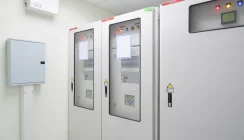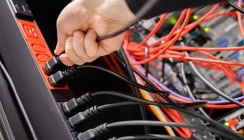Green Data Centre and Server Room Operations with CEEDA and ISO 50001
Energy efficiency is a growing concern for many organisations and no more so than in the world of data centres and server rooms. Apart from reducing carbon footprints and acting in more environmentally friendly way, energy efficiency also impacts the bottom line in terms of reduce electricity bills. CEEDA and ISO50001 certifications are ways to promote and practice energy efficiency but they differ in their scope and content and approach to building energy management.
What is a Building Energy Management System?
A Building Energy Management System (BeMS) is a management system for the monitoring and control of energy usage within a building with the goal of improving energy efficiency. A BeMS works on the principle of single and double-control loops and a ‘what you don’t monitor, you cannot control’ approach.
There are several well-known management systems used within many organisations including: quality (ISO 9001), environmental (ISO 14001) and health & safety (ISO 18001). ISO5 0001 operates to a very similar approach requiring a systematic implementation and is for the certification of building energy management system.
ISO 50001 and Server Room Operations
The ISO 50001 standard has an enterprise-wide focus and considers energy usage and its management throughout a building or set of buildings. Areas can include general offices, manufacturing, warehouses and computer and server room operations.
The standard looks to establish best practice in a range of different but related disciplines including energy monitoring and energy metering practices, energy awareness training and how corrective and preventative actions are implemented because of analysing recorded results.
Within a server room environment the focus could be on lighting, power, cooling and IT servers and how to monitor and improve their energy efficiency. The benefits of any refurbishments and upgrades could also be applied to the similar systems within a building. Examples would include adopting LED lighting and more energy efficient air conditioning systems. Key energy efficiency measures could also be applied to server rooms themselves to measure energy efficiency including Power Usage Effectiveness or PUE but considering the server room in isolation.
Most organisations will look to implement an EnMS using a team of both internal staff and an external energy efficiency/energy management consultant. The benefits of this teamwork like approach comes from combining the experience that comes from implementing systems across many other business and the sharing of knowledge and training with company staff and especially those who will be responsible for the day-to-day operation of the energy management system.
The process starts with a review of current energy management practices and costs. From this a benchmark level can be established and used as a basis for the establishment of an Energy Policy and the setting of corporate aims and objectives related to energy. The aims and objectives may cover financially orientated measures including energy costs as well as wider ones affecting the environment including lower environmental impact and carbon footprints.
Once the Energy Policy has been defined the next steps involve the design and implementation of a complete energy usage monitoring and control system. This can include the installation of new energy meters and monitors to capture data for analysis. The data may be analysed individually or collated and reviewed within energy management dashboard. The principles are the same in either case as the system revolves around defining acceptable levels, measurement, analysis and identification of points for investigation.
It is up to a business or organisation whether it applies for its EnMS to be certified to ISO 50001, but the recommendation is always there to do so; especially if the organisation already has certifications for quality, environmental and health & safety. Management system certifications like these demonstrate to clients and prospects that the organisation is investing its time and resources to improve its overall operations and impacts. There is a positive public relations message from this and many benefits for the organisation.
The first benefit from operating an ISO50001 certified EnMS is the improvement of energy efficiency, resulting in an improving working environment and lower operational costs including energy usage related costs. In addition, the cycle of ‘Plan-Check-Do’ helps to reinforce a culture of continuous improvement and in this case continuous energy efficiency improvement.
A well designed and implemented Energy Management System will not find ISO50001 certification a great hurdle and the benefits of this can include:
- Providing more accurate data from which to make better energy related decisions
- The tracking and monitoring of energy efficiency related improvements
- Monitoring the effectiveness of the Energy Policy and related organisational goals
- Continuous improvement within the organisation and a more positive culture
- Preparing plans in relation to energy usage and its management
- Greater collaboration across all levels within an organisation
- Greater awareness about energy usage and power sources within the organisation
- Greater awareness about how to raise operational efficiency
- Improved monitoring and tracking of energy prices, demand and supply
Other benefits that can accrue within an organisation include greater productivity and lower maintenance requirements. A more open and service orientated culture can also develop with significant contributions from across all levels within the organisation.
What is CEEDA?
CEEDA (Certified Energy Efficiency Datacentre Award) is an energy efficiency assessment framework covering OPEX, labour deployment and CAPEX in order to maximise performance. The certification helps datacentre organisations to demonstrate their commitment to sustainability, energy efficiency and overall bottom-line performance to their stakeholders.
CEEDA is different to ISO50001 in that it is more focused on datacentre operations than an entire building. CEEDA assesses and certifies energy efficient practices and systems and provides guidelines for proactive improvement. There are three levels of CEEDA certification including:
- Bronze: covering the use of separate environmental zones, variable speed fans and hot and cold-aisle containment.
- Silver: covering extended operating temperature and humidity ranges, heat pump waste heat reuse and free cooling.
- Gold: covering the use of dynamic air conditioning control, PDU outlet socket energy metering and environment monitoring.
CEEDA can be applied using frameworks for enterprise, colocation and telco data centres and both existing and new build facilities. For more information visit: https://www.ceedacert.com/
Summary
ISO 50001 is also a selling point and differentiator for an organisation in terms of wanting to lower energy usage and have less of carbon and environmental impact. Achieving ISO 50001 will impact computer and serve room facilities as part of an enterprise-wide approach to improving energy efficiency.
CEEDA is a datacentre focused energy efficiency standard. CEEDA may be more appropriate for small-to-medium colocation and hyperscale datacentres and can typically be achieved within a shorter-time frame than ISO 50001 as it is more focused on what should already be a higher energy efficient facility.
Committing to either ISO 50001or CEEDA (or both) will become more important within the UK and European IT market place. Energy efficiency improvement is a must for all organisations whether they run a small IT operation or large datacentre operations as governments strive to develop low carbon economies, meet their environmental commitments and reduce demand for electricity on their national grids.
Organisations like Server Room Environments can help with energy efficiency audits, the implementation of energy management and monitoring systems, and upgrades to the latest power and cooling technologies or their adoption into new build designs.


























